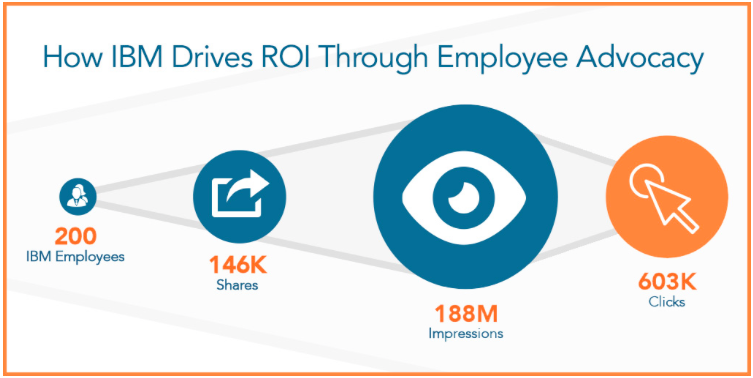Today, I had the good fortune of hosting and moderating a webinar How IBM Drives ROI Through Employee Advocacy, featuring my long time IBM colleagues Colleen Burns and Amber Armstrong, who shared several case studies about how the global tech giant is successfully proving ROI through employee advocacy.
For those of you who’ve followed me on twitter @sfemerick or read my blog or book, The Most Powerful Brand on Earth, you know I believe the most successful brand advocates are those who gain visibility and trust by sharing their expertise, and the most successful brands are those who build systems around these experts to align and scale impact for the brand. IBM has done just that.
Kicking off our discussion by establishing a common understanding of how we define Employee Advocacy – meaning: brands empowering employees to support the goals of the brand, using content and employee-owned social — As explained in the book, this could also be extended to business partners or even customers. (The full webinar on demand is available towards the end of this post.)
But why should brands care?
Well, for starters Employee Advocacy is the fastest growing and most effective means of driving brand engagement and advocacy at scale. Secondly, customers trust your experts and regular employees more than anyone else in your company.
In fact, people trust regular employees as credible spokespeople more than official brand sources like the CEO, as shown by the 20 point gain since 2009, in Edleman’s 2014 Trust Barometer study. In addition, the study reveals that employees rank highest overall 36%, as the most trusted influencer to communicate across 4 out of 5 topic categories including: Engagement, Integrity, Products & Services and Operations.
 Prove value to your stakeholders, or your program will be short lived
Prove value to your stakeholders, or your program will be short lived
If you’re contemplating an employee advocacy program, you’ll need to consider how you’re going to measure, demonstrate value and deliver results. If you miss this critical step, the likelihood of your program being short lived is pretty high because you won’t be able to secure the resources or investment you’ll need.
While ROI targets are typically financial, such as Increasing revenue or decreasing costs, they may also be non-financial such as increasing productivity, improving operational efficiency or reducing time to market which have financial implications. No matter which is right for your program, you need begin with establishing measurable ROI targets for the program up front. It’s not enough to set targets, you also have to determine how you’ll measure and report progress against them.
Another critical step is to consider what motivates stakeholders – depending which part of your company is sponsoring your program they will likely have different motivations and attainment measures, the details on addressing stakeholder motivations is explained in Chapter 7 of The Most Powerful Brand on Earth. We also dedicate a whole chapter to measurement, where you can find a roadmap of how build a measurement framework.
IBM’s a leader in social business, committed to driving transformation, paving the way for open collaboration and employee engagement
Colleen Burns, Manager of IBM’s Influencer Engagement Team, shared IBM’s belief that employees are one of the greatest sources of influence. Not just in IBM products, but in the entirety of the company. IBMers (as employees call themselves), play a critical role helping to set the agenda, as well as build and cultivate relationships.
The IBM Redbooks Thought Leaders Social Media Residency is a great example. The program was designed to create a pipeline of thought leadership blogs and help motivate technical employees to establish their personal social eminence while sharing their technical knowledge and expertise while building engagement opportunities. Since it’s inception in 2011, program participants have authored nearly 2,000 blogs across 11 business topics. In fact 800 posts published on IBM’s Thoughts On Cloud blog have accrued 1.1 Million visits and counting!
IBM’s Select program, designed to identify high-value experts to support social strategies aligned to go-to-market priorities, enabled SMEs to tag links and track inbound referrals from their personal blogs. This program has quantifiably outperformed traditional marketing and paid media tactics, proving digitally engaged experts could achieve a 33% conversion rate to a call to action.
IBM is also helping customers like Performance Bicycle achieve results by creating a community based learning center, which has become the Go-to destination for cycling enthusiasts. Moderated by employees that are cycling experts, they’ve achieved a 300% increase in traffic within first four months while proving a 20% higher conversion from the Learning Center compared to other referral sources.
IBM’s work with Illy, an Italian coffee and accessories retailer, resulted in a 40% increase in traffic to the retailer’s online shopping catalogue.
 Amber Armstrong, Program Director of IBM’s Social Business team, launched a unique employee advocacy program powered by Dynamic Signal with 200 initial subject matter experts (SMEs). This elite group drove 146K shares to date, resulting in 188M impressions and 603K clicks through to the call to action. An estimated cost savings on media spend between $300K – $1.2M.
Amber Armstrong, Program Director of IBM’s Social Business team, launched a unique employee advocacy program powered by Dynamic Signal with 200 initial subject matter experts (SMEs). This elite group drove 146K shares to date, resulting in 188M impressions and 603K clicks through to the call to action. An estimated cost savings on media spend between $300K – $1.2M.
 Wow! What an incredible demonstration of ROI
Wow! What an incredible demonstration of ROI
If you’re striving to build a successful employee advocacy program and missed today’s webinar, you can access the replay below, and can also follow and contribute to the dialogue on Twitter using the event’s hashtag #AdvocateArmy
A special thanks to our webinar sponsors BrightTalk and Dynamic Signal


